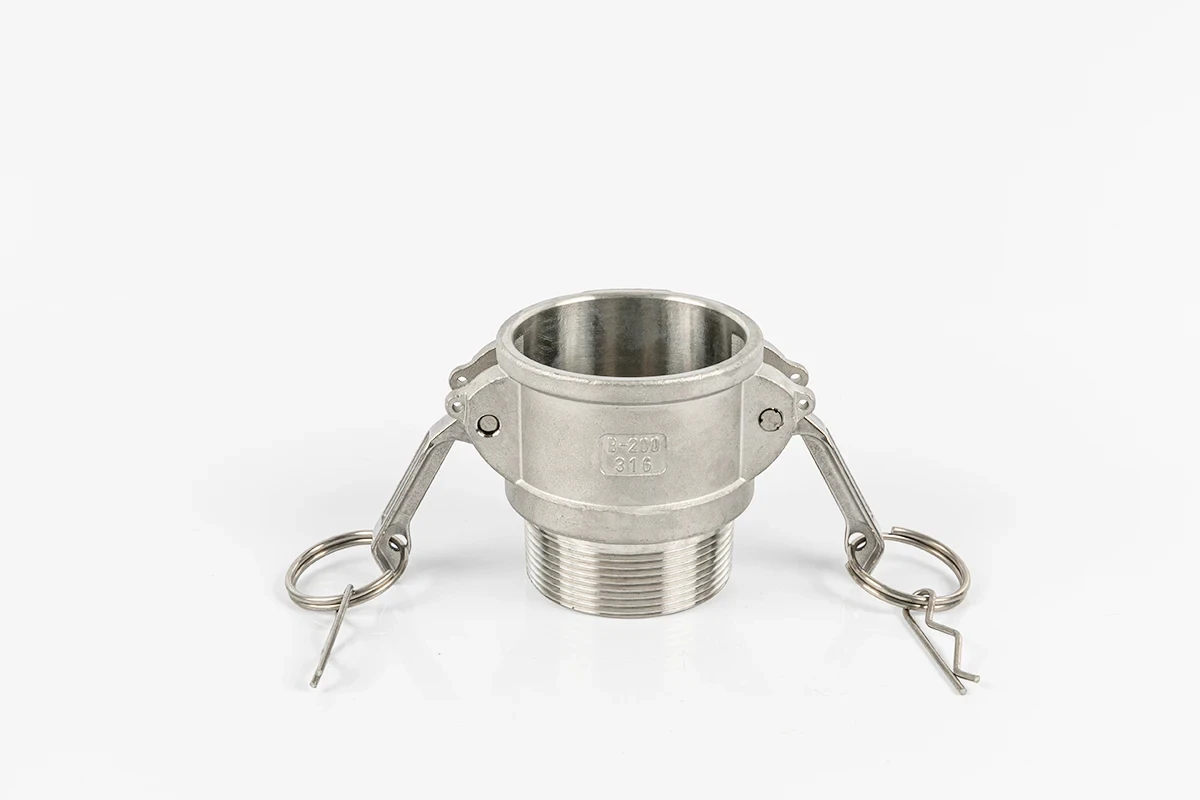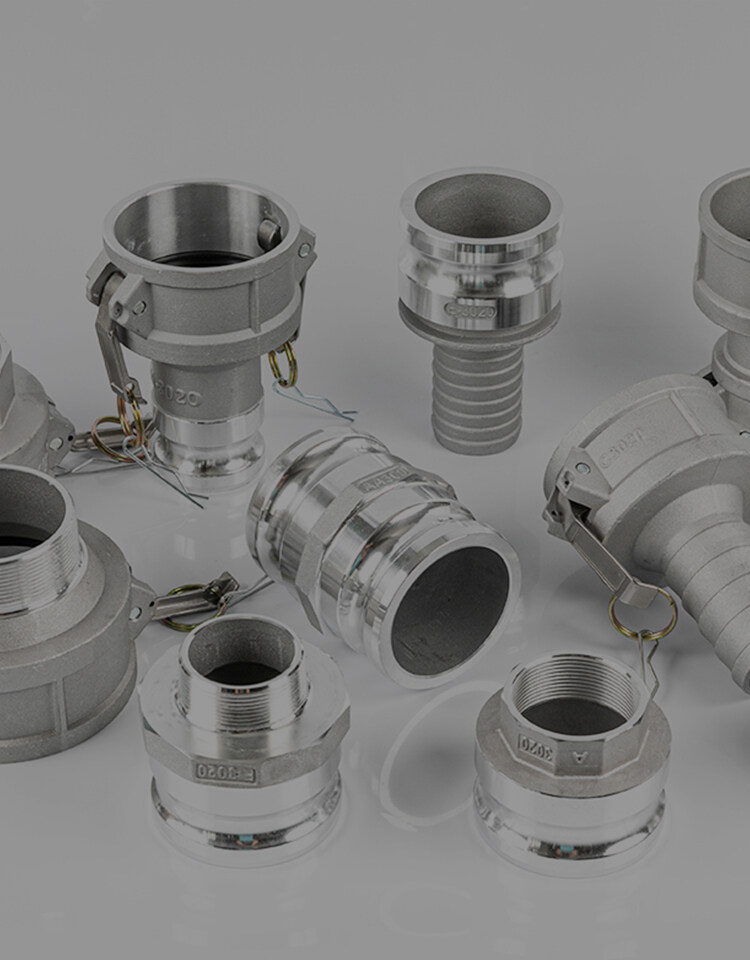Erreur de format d'e-mail
emailCannotEmpty
emailDoesExist
pwdLetterLimtTip
inconsistentPwd
pwdLetterLimtTip
inconsistentPwd

Nouvelles
Ici, vous pouvez décrire un morceau de texte que vous souhaitez exprimer

The Essential Guide to Cam and Groove Reducers in Fluid Handling Systems
Fluid handling systems are the backbone of many industrial operations, from chemical processing to water treatment facilities. The efficiency, safety, and reliability of these systems are paramount, and every component must be carefully selected to ensure optimal performance. One such component that often goes unnoticed but plays a critical role is the cam and groove reducer. This guide will take you through the ins and outs of cam and groove reducers, their importance in fluid handling, and how they work in harmony with other fittings like grooved couplings, adapter camlocks, and self-locking couplers.
Understanding Cam and Groove Reducers:
Cam and groove reducers, also known as camlock reducers, are designed to seamlessly connect two sections of piping or hose that have different diameters. These reducers are essential for transitioning between different sizes without compromising the flow rate or causing turbulence in the system. The ‘cam and groove’ part of the name refers to the locking mechanism that these fittings use. A cam (or lever) is used to tighten the groove into place, creating a secure seal that can withstand significant pressure without leaking.
The Importance of Compatibility:
Selecting the right cam and groove reducer for your system is not just a matter of size. Compatibility with the materials being transported, the pressure levels within the system, and the environmental conditions are all critical factors to consider. For instance, aluminium camlock reducers are a popular choice due to their resistance to corrosion and their lightweight nature, making them easy to handle and install. However, for more corrosive substances or higher-pressure applications, stainless steel or polypropylene might be more appropriate.
The Role of Grooved Couplings:
Grooved couplings are an essential part of many piping systems, providing a method for connecting pipes that allows for some degree of flexibility and movement. This flexibility can be crucial in systems that experience thermal expansion, vibration, or other dynamic forces. When paired with cam and groove reducers, grooved couplings can help to absorb these forces, preventing damage to the system and maintaining a secure connection.
Selecting the Right Adapter Camlock:
Adapter camlocks play a pivotal role in the versatility and adaptability of fluid handling systems. They serve as the connecting piece between the cam and groove reducer and various types of piping or hose ends, ensuring a secure and leak-free connection. The selection of the right adapter camlock is a critical decision that can affect the efficiency and safety of the entire system.
1. Understanding Adapter Camlocks:
Adapter camlocks come in a variety of shapes and sizes, each designed to connect with specific types of hose or pipe ends. The standard types of adapter camlocks include:
Type A: Male grooved adapter with a female threaded end.
Type B: Female grooved coupler with a male threaded end.
Type C: Female grooved coupler with a hose shank end for attaching to a hose.
Type D: Female grooved coupler with a female threaded end.
Type E: Male grooved adapter with a hose shank end for attaching to a hose.
Type F: Male grooved adapter with a male threaded end.
Each type of adapter camlock is designed to provide a secure connection while allowing for easy disconnection and reconnection, which is essential for maintenance, cleaning, or system reconfiguration.
2. Material Considerations:
The material of the adapter camlock is just as important as the type. Different materials offer different levels of resistance to chemicals, temperatures, and pressures. The most common materials for adapter camlocks include:
Brass: Brass adapter camlocks are known for their durability and corrosion resistance. They are suitable for water systems and can handle a variety of chemicals. Brass is also a non-sparking material, making it safe for use in environments where flammable substances are present.
Stainless Steel: Stainless steel adapter camlocks offer excellent resistance to corrosion and high temperatures, making them ideal for harsh chemical applications and high-pressure systems. They are also durable and can withstand aggressive cleaning processes.
Polypropylene: Polypropylene adapter camlocks are lightweight and offer good chemical resistance. They are often used in agricultural and water treatment applications where corrosion resistance is important but high pressure is not a concern.
3. Application-Specific Selection:
When selecting an adapter camlock, it’s essential to consider the specific requirements of the application. For instance, if the system will be used to transport abrasive materials, a stainless steel adapter may be preferred for its strength and durability. On the other hand, if the system requires frequent changes and lightweight components are a priority, polypropylene adapters may be the best choice.
4. Compatibility with Cam and Groove Reducer:
The adapter camlock must be compatible with the reducer in terms of size, material, and pressure rating. It’s important to ensure that the adapter can securely fit into the reducer and that the materials of both components are compatible with the fluid being handled. Additionally, the pressure rating of the adapter camlock should meet or exceed the maximum operating pressure of the system to prevent failures.
5. Sealing and Locking Mechanisms:
A proper seal is crucial for preventing leaks. Adapter camlocks typically use a gasket or O-ring made from materials like Buna-N, EPDM, or Viton, depending on the chemical compatibility required. The locking mechanism of the camlock should be easy to operate while providing a secure closure. Some adapter camlocks also feature safety clips or locking pins to prevent accidental disconnection.
The Convenience of Adapter Couplings:
Similar to adapter camlocks, adapter couplings are used to connect different types of ends permanently. They are typically more robust than camlocks and are used where a connection is not intended to be disconnected regularly. When integrating a reducer, an adapter coupling can provide a strong, permanent connection that can withstand the rigors of an industrial environment.
Advantages of Aluminium Camlock Reducers:
Aluminium camlock reducers are a favored choice in many industries due to their unique combination of properties that cater to a wide range of fluid handling applications. Below, we delve into the specific advantages that make the camlock reducers a go-to option for professionals looking to balance performance with cost-efficiency.
Lightweight Design: One of the most significant advantages is their lightweight nature. Aluminium, as a material, offers a density approximately one-third that of steel, which translates into fittings that are easier to handle and manipulate. This is particularly beneficial when dealing with larger-sized reducers, where the weight of the fitting can impact the ease of installation and the physical strain on workers. The reduced weight also means lower shipping costs and easier storage.
Ease of Installation: The lightweight characteristic directly contributes to their ease of installation. Workers can position and secure these reducers without the need for heavy lifting equipment or excessive manpower. This not only speeds up the installation process but also reduces the risk of injury on the job. Additionally, the camlock design allows for quick and tool-free connections, further simplifying the installation process.
Corrosion Resistance: Aluminium naturally forms a protective oxide layer when exposed to the atmosphere, which shields the material from further corrosion. This inherent resistance to corrosion makes the camlock reducers suitable for use in a variety of environments, particularly those where moisture is present. Whether the application involves water, certain chemicals, or exposure to outdoor elements, aluminium reducers maintain their integrity over time, ensuring a long service life.
Cost-Effectiveness: When it comes to cost, the camlock reducers are often more affordable than those made from stainless steel or brass. This cost-effectiveness makes them an attractive option for operations that require a large number of fittings or for budget-conscious projects. The lower cost does not come at the expense of quality or performance, making aluminium reducers a smart investment for both short-term and long-term applications.
Compatibility with Various Fluids: The camlock reducers are compatible with a range of fluids, making them versatile for different applications. They are commonly used with water, hydraulic oil, coolants, and gasoline, among other substances. However, it’s important to note that aluminium may not be suitable for all chemicals, particularly strong acids or alkalis, so it’s crucial to verify the chemical compatibility before use.
Thermal Conductivity: Aluminium has excellent thermal conductivity, which can be advantageous in applications where heat dissipation is desired. This property allows the camlock reducers to help regulate the temperature within the fluid handling system, potentially protecting sensitive fluids from temperature extremes.
Recyclability: Aluminium is a highly recyclable material, which adds an environmental benefit to its use in camlock reducers. At the end of their service life, aluminium fittings can be recycled without degradation of quality, contributing to a circular economy and reducing the environmental impact of the operation.
The Security of SELF-LOCKING COUPLERS:
SELF-LOCKING COUPLERS are designed to provide an additional level of security to the connection. They feature a locking mechanism that automatically engages when the coupler is connected, preventing accidental disconnection under pressure or due to vibration. When used with cam and groove reducers, self-locking couplers ensure a secure and reliable connection that can withstand the demands of an industrial fluid handling system.
Installation and Maintenance Tips:
Proper Installation:
Compatibility Check: Before installation, verify that the reducer is the correct size and material for the application, and that its pressure rating meets or exceeds the system’s requirements.
Seal Inspection: Inspect the seals and gaskets for any damage or imperfections that could compromise the connection.
Lubrication: Apply a suitable lubricant to the gasket and cam arms to ensure a smooth operation and to prevent galling, especially in metal-to-metal contact areas.
Alignment: Carefully align the reducer with the mating hose or pipe to avoid cross-threading or misalignment.
Secure Connection: Close the cam levers firmly to ensure a tight seal but avoid over-tightening, which can cause undue stress on the gasket and lead to premature wear or failure.
Regular Maintenance:
Inspection Schedule: Establish a regular inspection schedule to check for signs of wear, such as cracks, erosion, or gasket degradation.
Cleanliness: Keep the reducer clean from debris and buildup that could affect the seal or lead to corrosion.
Gasket Replacement: Replace gaskets and seals at the first sign of wear or according to the manufacturer’s recommendations to maintain a leak-free seal.
Tightness Check: Periodically check the tightness of the cam levers, as vibration and thermal cycling can cause them to loosen over time.
Record Keeping: Maintain records of maintenance activities to track the reducer’s performance and predict when parts may need replacement.
Troubleshooting Common Issues:
Leaks:
Seal Examination: Check the seals and gaskets for wear or damage. A compromised seal is often the culprit behind a leak.
Proper Closure: Ensure that the cam levers are properly closed. If they are not fully engaged, the connection may not be sealed correctly.
Gasket Replacement: If the gasket is worn or damaged, replace it with a new one that matches the specifications for the reducer.
Pressure Drops:
Blockage Check: Inspect the system for any blockages that could be causing a reduction in flow and pressure. Clean or remove any obstructions found.
Reducer Sizing: Confirm that the reducer is the correct size for the application. An incorrectly sized reducer can restrict flow and cause a drop in pressure.
Misalignment:
Support Structures: Check that the system is properly supported, especially near the reducer, to prevent sagging or misalignment.
Correct Installation: Verify that the reducer has been installed correctly, with the cam and groove ends properly aligned and secured.
Re-Alignment: If misalignment is detected, carefully realign the components and secure them in place to ensure a proper fit.
Case Studies:
Case Study 1: Chemical Processing Plant
In a chemical processing facility, the transfer of corrosive substances is a daily operation. The plant initially used stainless steel camlock fittings, but due to the high cost and the need for frequent replacements because of the aggressive nature of the chemicals, the facility was facing increased maintenance costs and downtime.
Solution: The plant switched to polypropylene cam and groove reducers, which offered excellent chemical resistance and reduced costs. The lightweight nature of the polypropylene fittings also made handling and changes quicker and safer for the workers.
Outcome: After the switch, the plant saw a significant reduction in maintenance costs and downtime. The polypropylene reducers proved to be durable against the corrosive chemicals, and the ease of use improved operational efficiency. The plant also benefited from the cost savings due to the lower price of polypropylene compared to stainless steel.
Case Study 2: Oil and Gas Industry
An offshore oil rig used a variety of hoses of different diameters for the transfer of crude oil. The mismatched hose sizes were causing issues with flow rates and were prone to leaks at the connection points, leading to environmental concerns and potential safety hazards.
Solution: The rig implemented aluminium cam and groove reducers to connect the mismatched hoses securely. The aluminium reducers were chosen for their corrosion resistance to seawater and their ability to withstand the mechanical stresses of the offshore environment.
Outcome: The introduction of the aluminium camlock reducers resulted in a more secure and efficient fluid transfer system. The reducers minimized leaks and ensured consistent flow rates, which improved the overall safety and environmental compliance of the rig’s operations.
Case Study 3: Agricultural Irrigation
A large agricultural operation was experiencing issues with their irrigation system, where varying pipe diameters were causing inefficiencies and water wastage. The system required frequent reconfiguration to meet the changing irrigation needs, which was time-consuming and labor-intensive.
Solution: The farm implemented cam and groove reducers made of aluminium to quickly and easily connect different pipe sizes. The camlock design allowed for rapid changes in the system without the need for tools, which was ideal for the farm’s dynamic requirements.
Outcome: The aluminium camlock reducers streamlined the irrigation process, allowing for quick adjustments and reducing water waste. The lightweight and durable nature of the aluminium fittings also meant they could be easily moved and reused across different parts of the farm, providing flexibility and cost savings.
Conclusion:
Cam and groove reducers are a small but crucial component in any fluid handling system. They ensure a secure transition between different-sized hoses and pipes, maintaining the integrity and efficiency of the operation. By understanding the importance of compatibility, the role of related fittings like grooved couplings and self-locking couplers, and the benefits of materials, you can select and maintain the right reducer for your system. Proper installation and regular maintenance will help to extend the life of your cam and groove reducers and keep your fluid handling system running smoothly.

